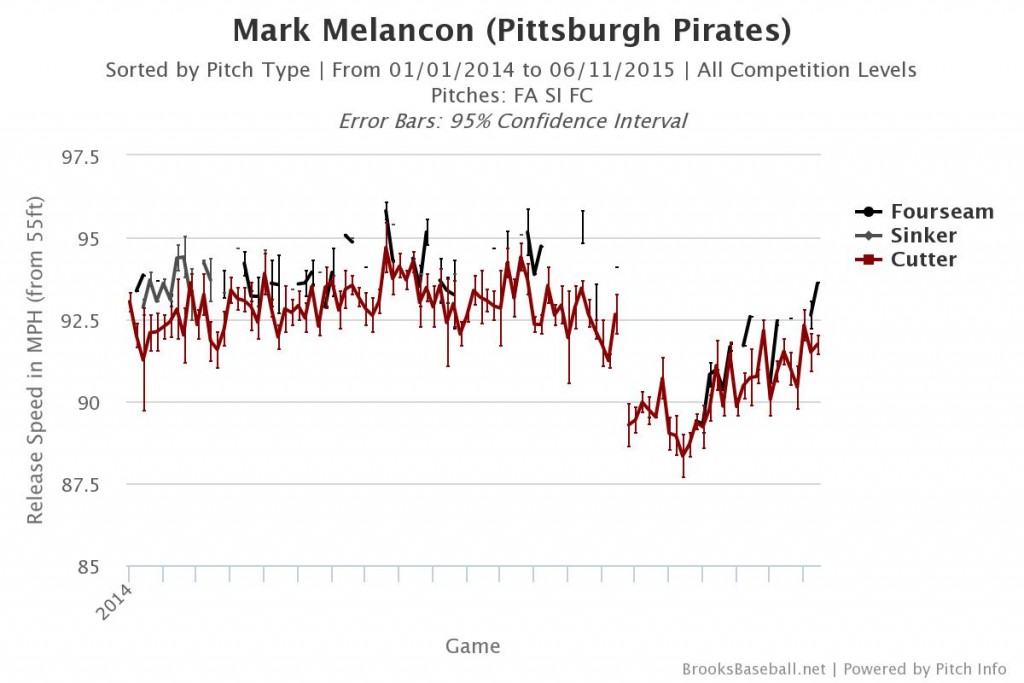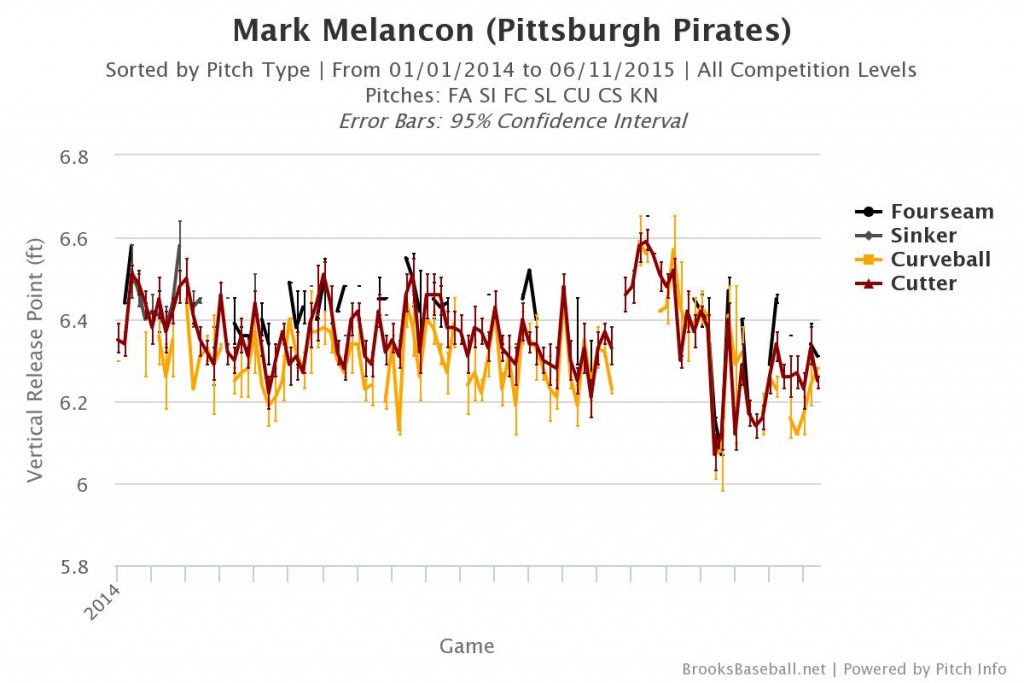If you just go by traditional stats, Mark Melancon’s been fine since his only blown save on April 21st. He’s pitched in 22 games since then, throwing 22 1/3 innings. He’s only allowed two runs in that span, he’s converted all 17 save opportunities he’s been given, and nothing he’s done in those 22 games has contributed to a Pirate loss. It’s hard for any relief pitcher to pitch better by those standards. There’s something weird about Melancon’s last 22 games, though: despite the great results, he’s barely striking anyone out. Over those 22 1/3 innings, he’s only got 11 strikeouts, which is a 4.43 K/9 rate. Melancon’s never been the sort of pitcher to strike out everyone he faces, but he struck out almost exactly a hitter an inning in his first two years in Pittsburgh (141 Ks in 142 innings), which was enough to balance his ground balls and make him a dominant reliever.
Melancon’s heavy cutter induces enough ground balls that he can probably get by as a decent reliever without a ton of strikeouts. Indeed, his SIERA (which adjusts for the concept that a higher ground ball rate means a lower BABIP) is 3.21, which is the best of his ERA estimators and really not all that bad. Still, the missing strikeouts mean that Melancon’s not the same pitcher that was one of baseball’s best relievers in 2013 and 2014, and I think that they make him awfully hard to trust in big situations. He’s essentially akin to a pre-2015 Jared Hughes. He’s able to get ground balls and the ground balls can bail him out of a lot of situations, but no matter how many times in a row he gets the job done, you can’t help but feel like he’s one pitch away from a meltdown.
When Melancon struggled in the early part of the season, I put a lot of emphasis on two things: his declining velocity and his weird release point. Both of those things have improved since April. Here’s a chart with the velocity of his cutter and fastball for each appearance this year, with 2014 for context:
 You’ll note that while his velocity is still a notch below where it was for most of last year, it’s trending upwards and his last couple appearances have been his hardest-throwing, which is a good sign. His release point is closer to where it was in the past, though it took a while and it’s kind of been all over the place this year (again, each data point is an individual appearance):
You’ll note that while his velocity is still a notch below where it was for most of last year, it’s trending upwards and his last couple appearances have been his hardest-throwing, which is a good sign. His release point is closer to where it was in the past, though it took a while and it’s kind of been all over the place this year (again, each data point is an individual appearance):
So, where are the strikeouts? The answer doesn’t lie in his cutter — I think it’s in his curveball. In his first two years with the Pirates, Melancon only had three full months (that means not counting Marches and Octobers) in which the whiff percentage on his curveball was below 30%. This year, it’s been under 30% in each month. He’s not missing as many bats with his hard stuff as he has in the past, but it’s definitely the curveball that looks the most dramatic. Here’s another chart with the visualization of his whiff rates (each data point is a month instead of a game in this one, to allow the data to stabilize some):
I’m not going to drown you with more charts here, but you can guess that the next step is to take the curveball and look at how its movement has changed and how that movement has changed relative to the velocity of the pitch (you can play around with the various measurements here). What you’ll find is that the break on the pitches hasn’t change much and that the main difference in Melancon’s curveball from last year to this year is, once again, the velocity.
I have one other observation — the speed gap between his curveball and his cutter has shrunk just a bit. In every single month of the first two years of his Pirate career, the difference between the velocity of his cutter and the velocity of his curveball has been at least 10 mph, and usually closer to 11 mph. This year, that difference has been closer to 9 mph. That’s mostly due to the cutter not quite being back up to normal Mark Melancon velocity, even though it’s improved. I don’t know if that’s enough to be the cause of the lower strikeout rate, but I suppose it could give us a hypothesis. That hypothesis would go something like this: the cutter being just a hair slower gives the hitters a split-second longer to react to the curveball, and as a result, Melancon’s not missing as many bats.
Melancon certainly looks better than he did in April and I don’t think there’s anyone that would dispute that. Even though his velocity is recovering, though, it’s not quite to where it was before this year. As a result of that he’s still not striking out nearly as many hitters as in the past. During this latest hot streak, he’s leaned heavily on a .214 BABIP. That’s obviously unsustainable, even for someone with Mark Melancon’s ability to generate ground balls. My biggest fear at this point is that that’s what’s going to catch up with him if the strikeouts don’t come back. That’s a big if, of course, since it still seems like his velocity is trending up and he did have two strikeouts in his save on Sunday against the Braves. Still, he’s not all the way back, yet, and I think it’s hard to not be a little worried about him in high leverage situations until he is.
Photo by Ezra Shaw/Getty Images






















